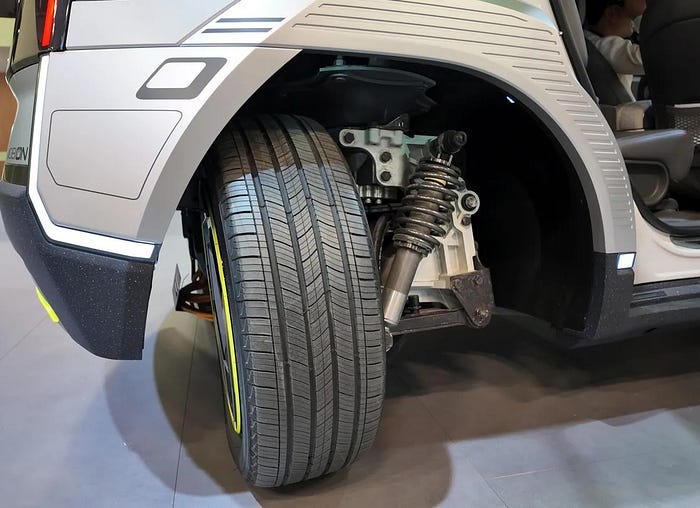Among the products Hyundai has unveiled at CES in Las Vegas is an innovation to its Ioniq 5 EV, the Mobis e-Corner System, which allows the wheels to be positioned completely perpendicular to the longitudinal axis of the vehicle, allowing for crab driving, zero turns, diagonal driving, pivot turns, and other unorthodox maneuvers, controlled by functions from the console and while the car projects arrows on the pavement to indicate its movements.
Innovation? Depends on your perspective. We have had vehicles with such features since the Roaring Twenties, a century ago, and they have always been considered a novelty that never took off. What's the difference today? But now we're now talking about EVs and can therefore eliminate the transmission, meaning everything can be done via the wheels: the motor, steering, damping and braking; as simple as that.
The Hyundai Mobis e-Corner system integrates driving, braking, steering and suspension systems within each wheel of the vehicle, which allows for a completely different driving approach. The wheels operate independently without any mechanical connection to other devices, because the four components of the in-wheel motor, electric brake, electric steering and shock absorber are combined: the motor mounted inside the wheel provides power directly, the electric steering changes the direction, while the electric brakes and shock absorbers respectively take care of slowing down (the brakes are hardly used in EVs under normal conditions) do their jobs. Basically, we eliminate the mechanical linkage between wheel and moving parts, or between wheel and wheel, allowing possibilities that could not be easily envisaged before.
Don't expect to find something like this in petrol or diesel cars other than military or concept vehicles, because the complexity of the drivetrain makes it impractical. When you have to rely on a mid-engine and transmit its motion to the wheels, the degrees of freedom for the manufacturer diminish appreciably.
As in the past, these features may seem gimmicky, and only caught my attention for what they mean in terms of greater freedom: when the motor becomes smaller and simpler, it can be placed on each axle or on each wheel, and delivers all the torque from the first moment, and opens the door to new possibilities, offering engineering, if it knows how to take advantage of them, many opportunities for innovation.
In fact, this is precisely the basis for the transition from an obsolete technology, the internal combustion engine, in which innovation was already purely incremental and scarce, to a new technology in which many of these degrees of freedom are still being explored and make possible features as yet unimagined. In practice, these degrees of freedom are not limited to engineering, but reach the entire value chain: EVs can be sold direct to the customer via a website, producing meaningful savings as dealerships are finally laid to rest.
For many, "it can't be done and it's impossible". "Dealer-less distribution? What happens when your car breaks down in the middle of nowhere!" Except that the mechanics are infinitely simpler, it's not a cuckoo clock with a thousand springs, which is why EVs never leave you stranded (and if they do break down, the manufacturer sends out a fully equipped mobile workshop).
Grasping the potential of EVs is about changing our mindset. But as we know, getting some people to rethink the world can be hard work.
(En español, aquí)


